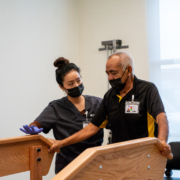10 Ways Families Can Support Aging Loved Ones at Home
As our family members get older, many of them want to continue living in their own homes. This is often called “aging in place.” It allows them to keep their independence and stay in a familiar, comfortable setting. For families, supporting aging loved one at home is a loving way to help them stay safe, healthy, and happy.
This guide offers 10 simple ways families can support their aging loved ones at home. These tips can help you provide the right care and make a positive difference in their daily lives.
Why Supporting Seniors at Home Matters
Helping an older adult live at home is about more than just convenience. It helps them feel in control of their lives and connected to their memories. When seniors stay in their own homes, they often report feeling happier and more content.
Family support is key to making this possible. By working together, you can help your loved one stay safe, manage their health, and feel connected to the people who care about them most.
1. Make the Home Safe
One of the first steps is to make sure your loved one’s home is safe. Simple changes can prevent falls and other accidents.
How to improve home safety:
- Remove clutter: Clear walkways of things like loose rugs, electrical cords, and piles of papers.
- Install grab bars: Add grab bars in the bathroom near the toilet and in the shower.
- Improve lighting: Make sure all rooms are well-lit. Use nightlights in hallways and bathrooms.
- Check smoke detectors: Test smoke and carbon monoxide detectors regularly and replace the batteries.
A safe home provides peace of mind for both you and your loved one.
2. Help with Regular Health Check-ups
Keeping up with doctor’s appointments is very important for seniors. Regular check-ups can catch health problems early.
How to help with healthcare:
- Keep a calendar: Mark down all doctor, dentist, and eye appointments.
- Offer rides: Driving your loved one to their appointments can be a big help.
- Take notes: During the visit, write down the doctor’s instructions so you can remember them later.
- Manage medications: Help organize pills in a weekly pill box to make sure they are taken correctly.
Staying on top of health visits helps manage chronic conditions and prevent new issues.
3. Encourage Social Connections
Loneliness can be a big problem for seniors who live alone. Feeling isolated can lead to depression and other health issues so it is important to maintain social connections.
Ways to promote social activity:
- Schedule regular visits: Plan visits from family and friends. Even a short chat can brighten their day.
- Use technology: Teach them how to use a smartphone or tablet to video call relatives.
- Find local senior groups: Look for community centers or clubs that offer activities for seniors.
- Share a meal: Eating together is a wonderful way to connect and spend quality time.
Keeping your loved one socially active is great for their mental and emotional health.
4. Assist with Healthy Meals
Good nutrition is vital for staying healthy and having energy. Some seniors may find it hard to shop for groceries or cook for themselves.
How to support healthy eating:
- Help with grocery shopping: Offer to pick up groceries or set up a delivery service.
- Prepare meals together: Make cooking a fun activity you can do together.
- Stock the freezer: Prepare meals in batches that can be frozen and easily reheated.
- Focus on simple, healthy foods: Encourage meals with fruits, vegetables, and lean protein.
A healthy diet can boost their immune system and improve their overall well-being.
5. Promote Gentle Physical Activity
Staying active is important for maintaining strength, balance, and a positive mood. Exercise doesn’t have to be difficult.
Simple ways to stay active:
- Go for walks: A short walk around the neighborhood is a great form of exercise.
- Try chair exercises: Gentle exercises done while sitting can improve flexibility.
- Do some gardening: Tending to plants is a light activity that gets them moving.
- Join a class: Look for senior fitness classes like gentle yoga or tai chi.
Encourage movement that is safe and enjoyable for your loved one.
6. Help with Household Chores
Keeping a house clean and organized can become difficult with age. A little help can make a big difference.
How to assist with chores:
- Create a cleaning schedule: Offer to help with tasks like vacuuming or dusting on a regular basis.
- Hire help if needed: If the workload is too much, consider hiring a cleaning service.
- Take care of yard work: Mowing the lawn, shoveling snow, or raking leaves can be tough for seniors.
- Organize mail and bills: Help sort through mail to make sure important bills are not missed.
A tidy home is a more pleasant and safer place to live.
7. Provide Emotional Support
Listening and showing you care is one of the most important things you can do. Aging can bring on feelings of anxiety or sadness.
Ways to offer emotional support:
- Listen patiently: Give them space to share their feelings and concerns without judgment.
- Be positive and encouraging: Celebrate small victories and remind them of their strengths.
- Respect their independence: Ask for their opinion and involve them in decisions about their care.
- Just be there: Sometimes, your presence is the most comforting thing of all.
Knowing they have someone to talk to can ease many of their worries.
8. Arrange Transportation
Losing the ability to drive can make a senior feel isolated. Helping them get around is a practical way to support their independence.
Transportation solutions:
- Offer rides: Drive them to the store, appointments, or social events.
- Use ride-sharing services: Teach them how to use services designed for seniors.
- Check public transit: Look into local bus or shuttle services that cater to older adults.
- Coordinate with other family members: Create a schedule so everyone can help with rides.
Reliable transportation allows them to stay connected to their community.
9. Plan for Emergencies
Having a plan in place for emergencies can reduce stress and ensure your loved one gets help quickly if needed.
Emergency planning tips:
- Create a contact list: Keep a list of emergency contacts, doctors, and family members by the phone.
- Consider a medical alert system: These devices allow seniors to call for help with the push of a button.
- Have important documents ready: Keep copies of medical history, insurance cards, and legal papers in an easy-to-find place.
- Talk about the plan: Make sure your loved one knows what to do in an emergency.
Being prepared can make a scary situation more manageable.
10. Take Care of Yourself
Being a caregiver for a loved one is rewarding, but it can also be stressful. It’s important to take care of your own well-being so you can provide the best support.
How to care for yourself:
- Ask for help: Don’t be afraid to ask other family members or friends to share the responsibilities.
- Take breaks: Set aside time for yourself to rest and recharge.
- Find a support group: Connecting with other caregivers can be a great source of comfort and advice.
- Stay healthy: Make sure you are eating well, exercising, and getting enough sleep.
When you take care of yourself, you are better able to care for others.
A Team Effort for a Happy Home
Supporting an aging loved one at home is a team effort. By working together, families can create a safe, loving, and supportive environment. These 10 tips provide a starting point for helping your loved one live independently and with dignity in the place they call home.
This blog is for informational purposes only and is not intended as professional advice. Always consult a qualified healthcare provider or specialist for specific questions or concerns.
It’s your life. Live it your way.
WelbeHealth provides full-service healthcare and personalized support to help your loved ones age well at home and in your community. Our Program of All-Inclusive Care for the Elderly (PACE) meets the changing needs of seniors, often at no cost, while helping you navigate life as a caregiver. To see if you qualify, call: (888) 750-0248 | TTY 711 or visit: welbehealth.com/contact


















































































